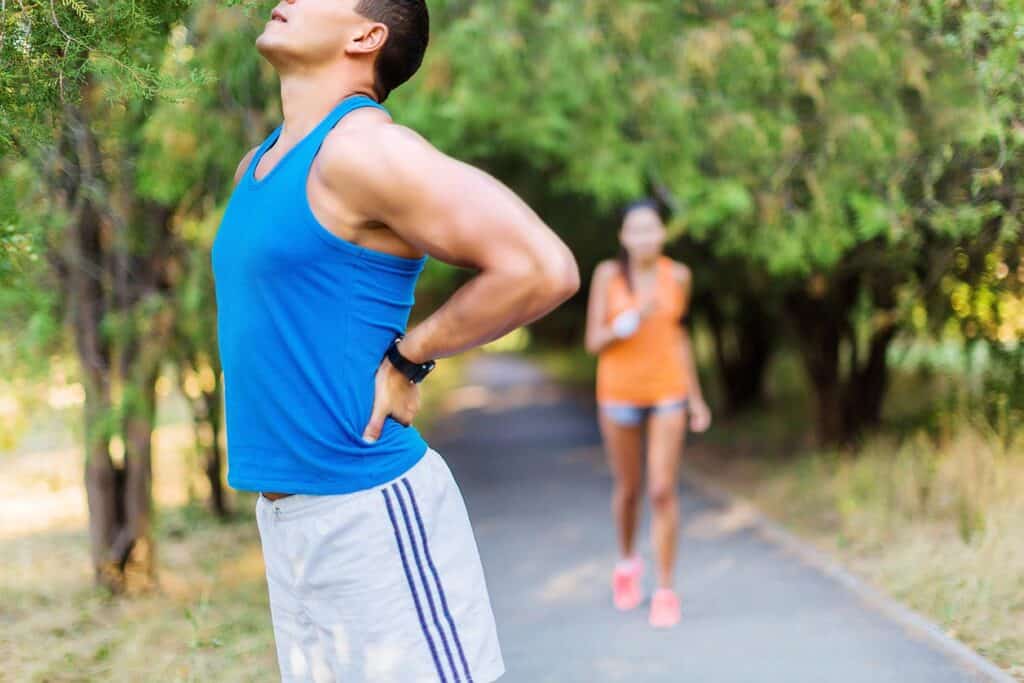Running is great exercise. It burns calories, keeps you fit, and releases endorphins to improve your focus and mood. When your back is healthy, running is enjoyable, but when you suffer from lower back pain, your ability to run is compromised and that can affect your mood and health.

Common Causes of Lower Back Pain in Runners
Running is considered a high-impact exercise, which means both feet are off the ground before returning forcefully to the surface. One drawback of high-impact exercises is the repetitive shock to the feet, knees, back, and spine. Running on a hard surface can also put stress on your vertebrae. A study measuring the spines of runners before and after running showed a marginal shortening of the spine after running.
The following are the most common back and spine injuries runners face:
- Herniated disc. The discs in your spine function as cushions between your vertebrae to buffer shock that hits the spine, as commonly found in running, plyometrics, and other impact aerobic exercises. Herniation happens when a disc gets pushed out of place, causing it to bulge or rupture. This can become extremely painful if the herniated disc contacts and rests on a nerve. Herniated discs commonly happen in a runner’s lower back, where much of the motion and shock take place.
- Degenerated disc. Disc degeneration disease occurs when you have a natural wear and tear breakdown of the vertebrae in your spine. As discs age, they weaken, became less flexible, lose water content, provide less cushion between the vertebrae. For older runners, those 30-50 years old and above, this can make running more painful.
- Overuse injuries. Sometimes lower back pain in runners comes through other causes. These can be overuse injuries from running too long too frequently (not enough time between runs)
- Bad Shoes. Runners can also get back pain from other causes like running in poor fitting, improperly fitting, or worn-out shoes. The unevenness of the tread caused by under or overpronation can cause unevenness in the runner’s gait, leading to lower back pain. People who have flat feet or high arches need to be more careful and buy special insoles that can correct this problem.
How Is Lower Back Pain Treated?
Usually rest and, if needed, muscle relaxants, pain killers and applying ice. Runners can strengthen core muscles by doing planks, bridges, crunches, and other exercises that help relieve the lower back pain and prevent it from recurring. This helps if running is your preferred form of fitness.
Ways to prevent low back pain in runners
Warm-up and cool-down exercises before and after running can help your back and other muscles experience less shock and pain. Doing range of motion exercises help to loosen any tight muscles.
Before running:
- Stand with both feet together and then put the right foot forward as far as possible. Bend the right knee (to 90 degrees) and the left knee until it nearly touches the ground. Hold the position for about 15 seconds and then stand straight. Do the same with the other side.
- Stand straight and put both arms up. Then move from the waist first one side and then the other, holding position for a few seconds each side.
- Lie flat on your back. Bend one leg at the knee and bring it forward to press on your chest, holding it with both arms. Hold for a few seconds and then take it back. Do the same with the other leg.
After running
- Kneel on one knee and put the other knee in front of your body. Move upper body forward from hips, hold position for a few seconds and then reverse the knees.
- Lie flat on your back and bend both legs at the knees. Bring knees towards your body from the hips and clasp your hands in the middle of your lower legs. Hold and relax.
- Stand and lift the right leg backwards at the knee and hold tight with the right hand. Then relax. Repeat this with the left leg and hand.
Do Running Surfaces Have An Impact On Back Pain?
Roads are the most common surfaces runners choose. School tracks are another. But hard surfaces like asphalt, concrete or cement can aggravate your back causing pain. Here are a few alternative terrains to try that may be gentler on your back:
- Park trails. These are typically natural earth surfaces in wooded areas or with the confines of a large park. Running on these surfaces allows ground to absorb some of the shock that your feet typically moves up your body.
- Hiking trails. Unlike flat found in park trails, hiking trails offer more uneven surfaces and elevation for a better workout that doesn’t put too much pressure on your back.
- Grass. This offers natural cushioning and is a low-impact option, provided the terrain is even.
Conclusion
Preventing lower back pain while running results from making sure you have the right shoes, the surface, and use proper stretching. If after running you experience persistent lower back pain, consult a doctor. Running is fun, but wise runners listen to their bodies and they don’t push through the pain.



